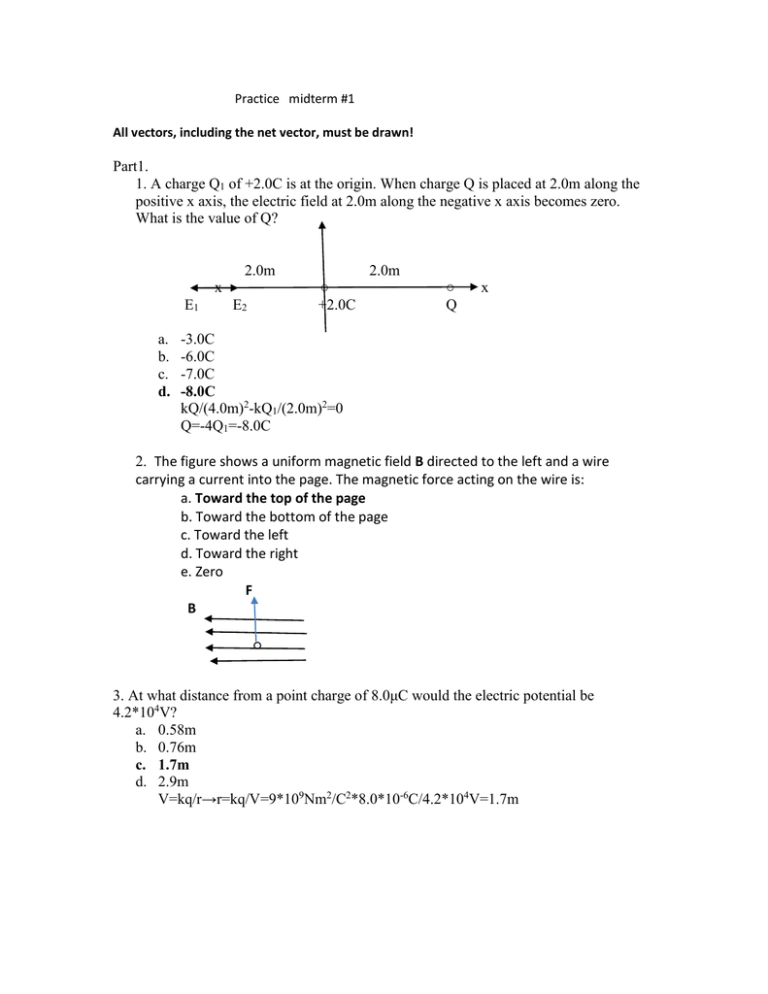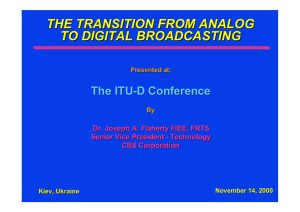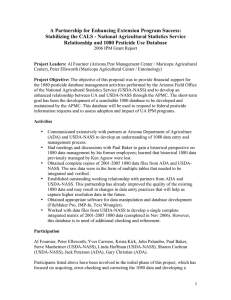Practice midterm #1
advertisement

Practice midterm #1 All vectors, including the net vector, must be drawn! Part1. 1. A charge Q1 of +2.0C is at the origin. When charge Q is placed at 2.0m along the positive x axis, the electric field at 2.0m along the negative x axis becomes zero. What is the value of Q? 2.0m x E1 a. b. c. d. 2.0m ○ +2.0C E2 ○ Q x -3.0C -6.0C -7.0C -8.0C kQ/(4.0m)2-kQ1/(2.0m)2=0 Q=-4Q1=-8.0C 2. The figure shows a uniform magnetic field B directed to the left and a wire carrying a current into the page. The magnetic force acting on the wire is: a. Toward the top of the page b. Toward the bottom of the page c. Toward the left d. Toward the right e. Zero F B ○ 3. At what distance from a point charge of 8.0μC would the electric potential be 4.2*104V? a. 0.58m b. 0.76m c. 1.7m d. 2.9m V=kq/r→r=kq/V=9*109Nm2/C2*8.0*10-6C/4.2*104V=1.7m 4. Two capacitors with CA greater than CB are connected in parallel with a battery . Which of the following is true? a. There is more potential difference across CA b. There is more potential difference across CB c. There is the same charge stored on each capacitor d. There is the same potential difference across each capacitor 5. When a light bulb is turned on, its resistance increases until it reaches operating temperature. What happens to the current in the bulb as it is warming up? a. It stays constant b. It increases c. It decreases d. It increases at first and then decreases. 6. Which two resistors are in parallel with each other? a. R and R4 b. R2 and R3 c. R2 and R4 d. R and R1 R ○ R1 R2 R3 R4 ○ 7. A high-voltage power line 20m above the ground carries a current of 2000A. What is the magnetic field due to the current directly underneath the power line? a. 20μT b. 35μT c. 14μT d. 0.30μT B=μ0I/2πd=4π*10-7 Tm/A*2000A/ 2π*20m=20μT Part 2. 1. You apply a potential difference of 9.00 V between the ends of a wire that is 2.50m in length and 0.654 mm in radius. The resultant current through the wire is 17.6 A. What is the resistivity of the wire? R=V/I=9.00V/17.6A=0.51 Ohm ρ=R*A/L=0.51 Ohm*π*(0.654*10-3m)2/2.50m=2.7*10-7Ohm*m 2. Charges of 4.0μ C and –6.0μC are placed at two corners of an equilateral triangle with sides of 0.10m. At the third corner: a. What are the x- and y- components of the resultant electric field? b. What is the magnitude of the resultant electric field? q2 ○ E2 E2y θ=60o E2x q1 ○ E1 E1=kq/r2=9*109Nm2/C2*4.0*10-6C/0.01m2=3.6*106N/C E2=kq/r2=9*109Nm2/C2*6.0*10-6C/0.01m2=5.4*106N/C E1x=3.6*106N/C; E1y=0 E2x=-5.4*106N/C*cos60o=-2.7*106N/C E2y=5.4*106N/C*sin60o=4.7*106N/C Enetx=0.9*106N/C Enety=4.7*106N/C Enet=sqrt(0.92+4.72)* 106N/C=4.8*106N/C 3. The combination of capacitors is shown on a drawing. a. What is the equivalent capacitance of the combination shown? b. What is the voltage across 20μF capacitor? Vab=100V 20 μF 12 μF 24 μF a• •b 12 μF 12μF C2 and C3 are in series: C23=(1/12+1/24)-1 μF=8.0 μF C4 and C5 are in series: C45=(1/12+1/12)-1 μF=6.0 μF C23 and C45 are in parallel: C2345=14µ C1 and C2345 are in series: Ceq=(1/20+1/14)-1 µF=8.2µ C1= 20 μF C23= 8.0 μF C1 a• •b C2345 a• Ceq • b a• •b C45= 6.0 μF Q=Ceq*V=8.2 μF*100V=820 μC=Q1 V1=Q1/C1=820 μC/20 μF=41V 4. Two long straight wires are perpendicular to the plane of the paper as shown in the drawing. Each wire carries a current of magnitude I=10.0A. The currents are directed out of the paper toward you. Determine the magnitude and direction of the total magnetic field at the origin of the x,y coordinate system. y B1 .x1=-0.12m x2=0.24m x B2 B=μ0I/2πd B1= μ0I/2πd1=4π*10-7Tm/A*10.0A/2π*0.12m=1.67*10-5T, in the positive y- direction (rhr) B2= μ0I/2πd2=4π*10-7Tm/A*10.0A/2π*0.24m=0.83*10-5T, in the negative y- direction (rhr) Bnet=B1-B2=0.83*10-5T, in the positive y- direction 5. Four resistors and a 6.0-V battery are arranged as shown in the circuit diagram. a. Find the equivalent resistance of the circuit b. Find the current through the 10-Ohm resistor c. Find the power delivered to the 10-Ohm resistor R1=40Ω I3 ○ I=I1 I2 R2=30Ω R4=20Ω ○ I4 R3=10Ω R1=40Ω ○ I=I1 I23 R23=7.5Ω R4=20Ω I4 ○ R2 and R3 are in parallel: R23=(1/30+1/10)-1Ω=7.5Ω R2, R23 and R4 are in series: a. Req=(40+7.5+20)Ω=67.5Ω b. I=I1=I4=I23= 6.0V/67.5Ω=90mA V23=V2=V3=I23*R23=0.09A*7.5Ω=0.68V P3=V32/R3=(0.68V)2/10Ω=0.046W






